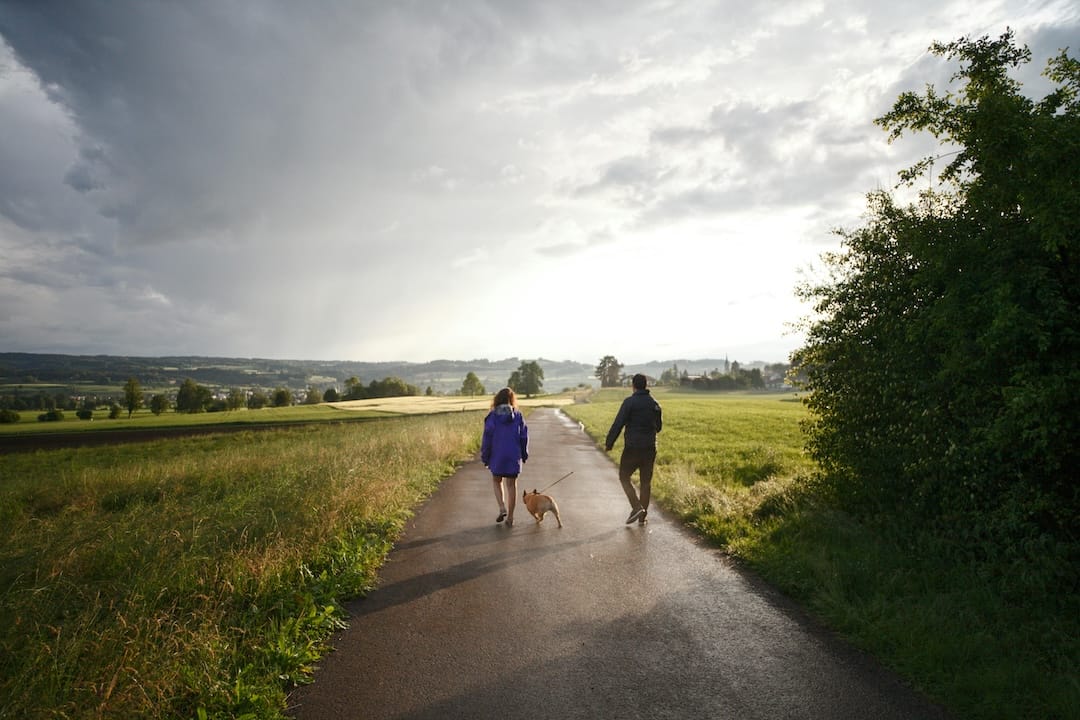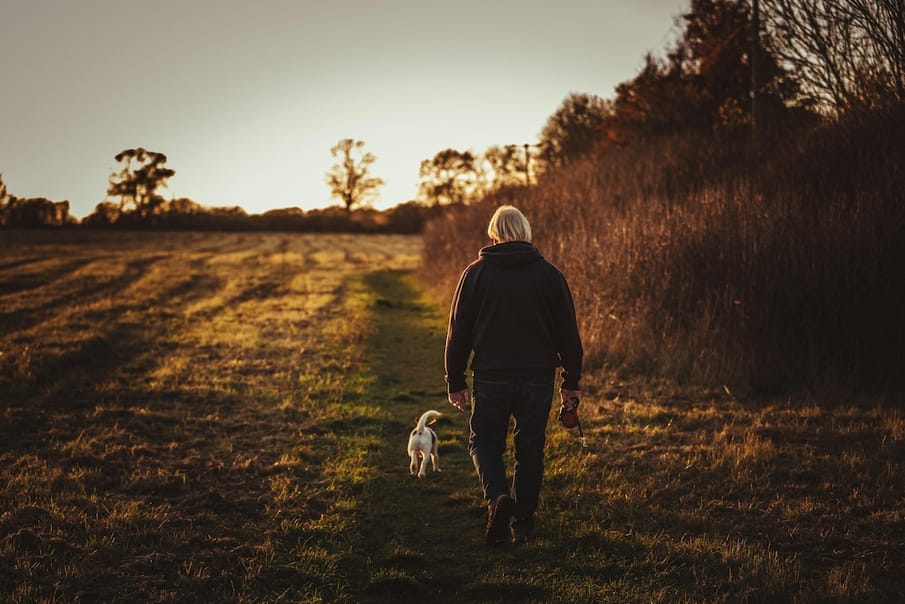From quiet, solitary wanders to walk and talk therapy, how can we use the simple act of walking to support our health and wellbeing?
I could follow this route in my sleep. Cross the road and turn left. Take a right by the library and you’re into a small field with a stream running by its side. Somewhere near here, someone keeps chickens in their garden; although you can’t see them, you can hear their clucks and coos. Cross another road and you’re back on quiet lanes. Eventually, you’ll pass two alpacas and a rescue horse behind a half-height stone wall, before taking a turn to cross the stream again and head back into town. Then, return home, with a head that feels clearer for your outdoor exploits.
Sometimes, a walk is a solution. It’s the remedy for a tired mind after a long day, it’s a respite from monotony, and it’s a blank slate for the steady flow of fresh thoughts. Sometimes it’s simply a gentle form of exercise that gets you from A to B but, even so, it always seems to have meaning of some sort.
In her book, 52 Ways to Walk, Annabel Streets explores the science of walking for wellness and joy one week at a time, calling on us to rethink walking, “to reclaim it from our molecular memories”.
“Think of it as a means of unravelling towns and cities,” she writes. “Of connecting with nature, of bonding with our dogs, of fostering friendships, of finding faith and freedom, of giving two fingers to air-polluting traffic, of nurturing our sense of smell, of satisfying our cravings for starlight and darkness, of helping us appreciate the exquisitely complicated and beautiful world we inhabit.”
Cast your mind back to the unseasonably warm March of 2020, when the UK entered the first national lockdown. Several studies since have confirmed what many of us could have predicted: the number of people going on walks spiked, and four years later, many have kept up the habit. With restrictions around how we could socialise, meeting up outside became the solution to staying in touch with loved ones. It presented the challenge to try out new ways of doing things, as counsellor Nigel Moyse discovered when he began taking his sessions out of the counselling room to try walking therapy.
“I actually read about it on the internet and thought, wow, that sounds like a great idea. But I never got around to it until, during one of the lockdowns, I was contacted by a past client who I’d got on really well with. We had closed the counselling room I was using, and agreed that we weren’t going to open it again for several months. So, I thought, what if I offer him walking therapy? I was highly sceptical as to whether it would work. He was sceptical too, but we tried it and he’s never looked back.”
Walking therapy, also called ‘walk and talk therapy’, takes traditional counselling sessions outdoors – and it soon became a staple offering for Nigel. After a first session in a counselling room, Nigel offers to meet his clients at their preferred location – covering natural spaces, parklands, and canal paths. They then, as you might expect, walk and talk.
The benefits of ecotherapy can still be enjoyed without the walking requirement. Outdoor therapy allows you to embrace opening up in a fresh, less formal environment, and find support.
When we meet – in a busy Oxford café after the walk that we had planned is rained off – Nigel shows me his copy of The Alter Ego Effect by Canadian performance coach Todd Herman. Nigel points to a moment in the book when Todd writes about his own kind of walk and talk he does with clients. “I’ll almost always take them for a walk along the Hudson,” he writes. “We walk because, in my experience, humans are more prone to open up when they’re moving. Plus the fresh air and exercise never hurt.”
I put it to Nigel that there’s something less confrontational about opening up when you’re walking, and he agrees.
“You’re walking side by side, you’re not looking into each other’s eyes,” Nigel says. “That might be intimidating for some people, having someone looking at them the whole time. And I think some clients are still slightly sceptical or just frightened of therapy in general. I think that’s just because they’re worried about being exposed. In reality, I don’t think therapy is necessarily as powerful as people fear. You don’t have to tell a therapist everything about yourself. I very often say to clients, please don’t tell me things you don’t want to tell me. It’s very important.”

The sure-footed, empathetic approach that Nigel describes, which combines the wellbeing benefits of talking therapy and gentle exercise, contrasts the more formal picture many may imagine therapy to be. But it’s also miles away from what Nigel experienced the first time he attended.
“The very first therapist I ever went to was actually a psychoanalyst in Italy, and he didn’t say anything,” Nigel shares. “He just looked at me with a very severe face. I was really quite frightened and I never went back. In those days, the idea was to not say anything, and let the anxiety build up in the client to the extent that they would blurt out things they didn’t really necessarily mean to say.”
The scene that Nigel recalls feels worlds away from the vision of two people walking side by side, gradually talking through problems, while trust naturally grows. And while research into walk and talk is in its infancy, one small-scale study that looked at 40 participants over a programme of 12–18 weeks, published in the Journal of Environmental Psychology in 2021, found that walk and talk coaching in a natural setting can be particularly effective for reducing symptoms of burnout, with some mental health improvements already visible after only the second walk.
Back to Annabel Streets and 52 Ways to Walk, and she also writes about walking meditation – the practice of combining meditation with movement and fresh air. The principles of walking meditation involve maintaining awareness of your body as you move, perhaps syncing your breath with the steps that you take, and making an effort to remain present, but the precise details will be led by you alone.
“There is no right or wrong way to do walking meditation, no recommended speed, timing, posture or location,” Annabel writes. “The point is to use the physical process of walking to bring your attention entirely to the present.”
Coincidentally, the day that I write this is the day that a landmark study of 70,000 people, published in the British Journal of Sports Medicine, found that every extra step above 2,200 steps a day lowers the risk of heart disease and early death, even when spending the rest of the day sedentary. It’s a reminder that – whether it’s getting out for a walk around the block on lunch, meeting up with a friend in a park, having difficult conversations on-the-go, or taking what we thought we knew about therapy and making it something new – with slow and steady progress we can reach our goals, whatever they may be, by taking one step at a time.


Comments